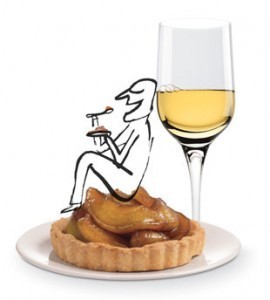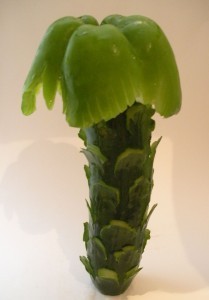Barbara Nowak's Blog
May 18, 2012
Sweet wines: The Boone’s Farm Backlash
Just say, “I like wines that are on the sweet side,” and you’ll get ugly, condescending stares. It’s not fashionable to like sweet wines. We don’t know why. Maybe it’s a Boone’s Farm backlash. But we think it’s just plain wrong.
When we say “sweet,” we’re not talking about dessert wines or the cloying, sugar-infused pink wines. We mean elegant, well-made wines that just happen to impart the soft whisper of sweetness. There’s a term to describe these wines that will disarm the patronizing wine snobs who are looking down their noses at you: off dry.
We don’t know who came up with this descriptor, but we’re willing to bet that it was coined by wine marketers to sell more sweet-ish wines to buyers who were too embarrassed to admit they were looking for a bit of a sugar fix in their wines. We’ve noticed in our wine classes, though, that most of the sweet wine drinkers haven’t heard of the term off dry. So we’re here to let you in on that sweet little secret.
What wines might qualify as off dry? It’s hard to generalize because wines can be made in so many styles . . . but your best chances are with Riesling, Gewürztraminer, Chenin Blanc and Rosé. Sweet red wines that aren’t dessert wines are more difficult to find. But to tell whether or not a wine is sweet, check out the alcohol content listed on the label. A rule of thumb is that the lower the alcohol level (8-12%), the higher the residual sugar content and the sweeter the wine .
Do you have a favorite off-dry wine? We’d like to know. If you’re brave enough to confess you have a vinous sweet-tooth, email us with your recommendations.
[image error]
April 27, 2012
Sending Wine Back
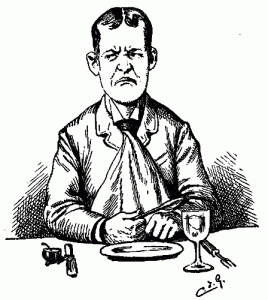
That wine was not to my superior taste!
Boy, have we heard stories of blowhards who order a bottle of wine and then reject it in a loud and animated fashion so everyone in the restaurant can see how much they know about wine. Who do they think they’re impressing?
Scenes like that make the rest of us reticent about sending a bottle of wine back – even when it’s warranted. So, when is it warranted?
When you stick your nose into your glass to get a good whiff of the wine you ordered, you’ll probably be able to tell if something isn’t right. Rather than being met with the fresh and fruity scent of berries, you’re greeted with smells that can be categorized, at best, as disagreeable.
Nine times out of ten your nose knows. If you’d prefer to rely on your palate, go ahead and taste. It won’t hurt you. It’ll probably confirm what you already know: Anything that smells like that isn’t something you’re about to gag down.
Off aromas can remind us of other everyday smells. We just don’t want to smell them in our wine. Here are five aromas to look for. Even a hint of one of them could be good reason to send a wine back.
• Rotten eggs – from too much sulfur used in making the wine.
• Nail polish remover – due to a bacterial spoilage.
• Wet newspaper – resulting from a cork tainted with a chemical called TCA.
• Burnt marshmallow – from oxidation when the wine has been stored improperly.
• Sweaty horse blanket – caused by a yeast spoilage know as “brett.”
Rejecting a wine is justifiable when it’s flawed. And you don’t have to be timid about sending it back when you recognize those flaws.
[image error]
April 14, 2012
Here’s to Your (and Our) Health!
We attended a party last week where the recently married hosts touted the benefits of red wine. It seems that the groom had been living with high cholesterol for many years and now, after six months of marriage, his cholesterol is normal – without medication. The miracle? The bride says that it’s the red wine. Before the happy couple met, the bride was a red wine drinker and the groom a total abstainer. As she puts it, “I told him right away I was not giving up my red wine!” So beat ‘em or join ‘em? He joined.
We’ve all heard about the heart healthy benefits of red wine, but what are they and are they real? While we’re not medical professionals, we’ve done a bunch of research on the subject. It seems that the antioxidants in red wine may help prevent heart disease by increasing levels of good cholesterol and protecting against artery damage and blood clots. Antioxidants in red wine are called polyphenols. One polyphenol that is constantly in the news is resveratrol, which is the strongest antioxidant found in nature.
The resveratrol in red wine comes from the skins of grapes used to make the wine. While all wine – red, white and pink contain some resveratrol, red wine has the most because the wine is fermented with the grape skins, which remain in longer contact with the juice than a white or blush wine.
You can also get the benefits of resveratrol by taking resveratrol supplements or eating foods that contain some of this power antioxidant, such as blueberries and cranberries – and even dark chocolate.
Resveratrol has also been linked to the French Paradox – the general observation that the French population tends to consume a good bit of red wine and foods high in fat (cheese, butter and creamy sauces) yet maintains relatively low levels of cardiovascular diseases.
According to the Mayo Clinic, some research does verify that resveratrol is linked to a reduced risk of inflammation and blood clotting, both of which can lead to heart disease. But they say that more research is needed since most research has been done on animals, not people.
While we’ve been doing our own research over many years, we can report that we both have healthy levels of good and bad cholesterol. Whether we were just born with good genes or it’s actually our wine consumption, we don’t know. But just in case…we continue to raise our glasses of red wine and offer a toast to its many benefits!

Tasting Pietra Santa Cab in their Hollister, CA Tasting Room
[image error]
April 6, 2012
Tequila Makes Her Clothes Fall Off
A few weeks ago George Clooney announced he’s launching a tequila brand called Casamigos Tequila. He’s partnering with restaurateur Rande Gerber, who happens to be husband to supermodel Cindy Crawford. This got us to thinking about the lyrics to the Joe Nichols song (She can handle any Champagne brunch/Bridal shower with Bacardi punch/Jell-o shooters full of Smirnoff…But tequila makes her clothes fall off). Okay, no disrobing for George, but the power of tequila can make a girl do strange things.
In a lot of ways tequila resembles wine. Not the least of which is what happens after you open the bottle. Like wine, tequila loses its zest when it’s exposed to the air. An opened bottle may last longer than its vinous counterpart, but it’s best to drink it up within a month or two.
And we’re sure you know the concept that Champagne is a type of sparkling wine, but not all sparkling wines are Champagne. Same principle applies to tequila. Tequila is a type of mezcal, but mezcals aren’t tequilas. Mezcal can be made from five different varieties of the agave plant. Tequila is made only from the blue agave (which, by the way, is a succulent, not a cactus).
Tequila has way more cachet than mezcal…and the prices to prove it. After tequila is fermented, it – by law – has to be distilled twice. Most mezcal only gets one distillation. Given the huge popularity of tequila, mezcal producers are getting smart and starting to produce premium products too.
Right now there are about 1,000 brands of tequila made. If you’re looking for a premium product, make sure the label says “100% blue agave.” If it doesn’t, it can have up to 49% added coloring and flavoring ingredients – usually caramel and sometimes oak essence. These blended tequilas are known as mixtos. Cuervo Gold is an example, which is still one of the world’s best selling tequilas.
All tequila starts out clear right after distillation. If it’s bottled immediately in this form, it’s called blanco or plata (white or silver). Some people think it’s harsh…and others think it is more robust with more of the agave flavor. Our opinion is that it makes the best Margaritas.
The color of other 100% agave tequilas comes from aging in oak barrels. The longer the aging, the darker the color and the more the wood affects the flavor. Reposado (rested) tequila is aged from two months to one year. Añejo (aged or old) tequila is aged from one year to ten. All types of tequila have about the same amount of alcohol – around 38-40% (76-80 proof).

Sharing a margarita with our saucy brother, Jeff
And what about the worm? No Mexican-bottled tequila has a worm. Some – but not all – mezcals have a worm in the bottle. It started out as a marketing ploy in the 1940s to try to get some attention. Guess it worked.
[image error]
April 3, 2012
Polish Wine for Easter? Not this year!
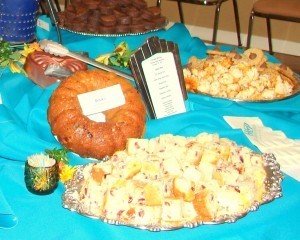
Saucy Sisters' Babka
Last October we hosted the opening night party for the cast and patrons of the play, The Kitchen Witches, at the Highlands, N.C. Performing Arts Center. The play is about two mature female cable TV cooking show hosts who’ve had an ongoing 30-year feud – both in the kitchen and in their personal lives. While the play has the two characters cooking up more insults than food, it does feature one baked treat called Babka, which is a traditional Polish Easter cake.
Because we wanted to maintain the theme of the play for our party, we decided to whip up some Babka. After several attempts and three days in the kitchen we came up with our version of the Easter favorite – soaked in rum. Sure, we thought of trying vodka – THE Polish spirit – but figured it just didn’t have the flavor needed for this dessert. See our recipe at our website. http://www.saucysisters.com/index.php?p=Recipes&objectId=27
We’re planning to make Babka this week for our Easter celebration. But this got us to thinking – how about pairing it with a Polish wine? We thought the cake was difficult!
Prior to World War II, vineyards were numerous in Poland – particularly along the western border of Germany, where some of the best-regarded sparkling wines were produced. But with the advent of communism, winemaking collapsed and was practically nonexistent until early this century. Recent new plantings – mostly in the country’s southeast region – have started to revitalize the Polish wine industry. Varietals such as Rondo, Seyval Blanc (widely grown in Michigan and New York) and Riesling are able to cope with the extreme cold and frost and are being made into some good quality wines. Many Polish wine enthusiasts are supporting the industry and winemaking has become a fashionable activity for the business elite.
However, stateside, we’ll have to wait a bit. Polish wine is not exported much. As a matter of fact, we called the Brentwood wine shops and not one wine store carries Polish wine. So unless you’re planning a trip to Poland soon, you’ll have to make do with some Babka and rum.
Na zdrowie!
Barbara and Beverly
[image error]
March 28, 2012
Drink Spring! Let us Pour you a spring cocktail
Five years ago these wine girls signed up for bartending school. Yup. Classroom, books, exams and all. For fourteen days we mixed, counted, spilled, blended, broke, dumped, shook, sprayed, stirred, strained and, yes, poured hundreds of cocktails. Even memorized the recipes for 100 of them – down to amount of ice, type of glass, ounces of alcohol, and even what kind of garnish. What a test of our brain cells. For our final, we had to make twelve drinks in eight minutes as they were “ordered” by our instructor. They could have been any of the hundred drinks. We both passed and received our “Mixology Certification,” which is only valid for five years.
So it’s time to renew. Last Sunday we headed back to school to take our state exam. In preparation, we spent time behind the bar and stirred up some new cocktails. With the warm spring weather, we leaned toward drinks that are colorful and refreshing and called them our “Vernal Libations.” Here’s a toast to you and Spring!
Springtime in Pear-adise
½ oz. Pear Schnapps
½ oz. Pear flavored Vodka
½ oz. Pear Nectar
Champagne
Pour schnapps, vodka and pear nectar into a champagne flute. Fill with champagne. Garnish rim with a strawberry.
Key to Happiness
1 oz. Lime flavored Vodka
½ oz. Crème de Cassis
½ oz. Key Lime Juice
½ oz. Orange Juice
Sparkling Wine
Shake Vodka, Crème de Cassis and Key Lime Juice in cocktail shaker filled with 1/3 cubed ice. Strain into an ice-filled highball glass. Top with Sparkling Wine. Garnish with lime twist.
Key limes are also called the Bartender’s Lime. They’re aromatic and very juicy, with a stronger and more acidic flavor than Persian limes (the common grocery store lime). Key limes are grown in the Florida Keys, West Indies, and Indonesia. Mostly known for use in Key Lime Pie, the fruit of the Key Lime is perfect for cocktails with vodka or rum.
Spring Fever
1 ½ oz. Raspberry flavored Vodka
½ oz. Curacao
¼ oz. Lime Juice
3 oz. Cranberry Juice
Pour all ingredients over ice in a mixing glass. Stir and strain into a martini glass. Garnish with lime wedge.
Cheers!
Barbara & Beverly
[image error]
February 27, 2012
What’s with the Legs!
If you were watching the Academy Awards last night, you couldn’t have missed Angelina Jolie repeatedly exposing her leg to the cameras. What a show-off! We were sitting in our hotel room in Las Vegas as witnesses and couldn’t help but howl in laughter when the winner for Best Adapted Screenplay took the stage and “imitated” her stance.
Reminds us of how some know-it-all wine drinkers try to show off their smarts by commenting on a wine’s legs — like the legs are an indication of quality. Not! Legs (those streams of wine that slide down the inside of the wine glass after it’s been swirled) are primarily an indication of the level of alcohol.
Having great legs doesn’t mean you’re heads and shoulders above all the rest…That goes for people and wine.
[image error]
June 15, 2011
Wines for the Golfing Dad
I was out looking at Father’s Day cards today. Cards I could get for Paul and sign from our dogs and cat. I didn’t find anything that knocked my socks off – so I guess I’ll have to up the ante and buy a gift. One thing I know for sure: it won’t be wine. Paul is not a wine guy.
My Dad was the wine guy. (I know, it’s hard to believe the Saucy Sisters had a Dad who was into the vino.) He was no elitist collector of fine wines. He liked value priced wines that he could drink today. We used to have daily telephone conversations around cocktail hour, and the subject of his new wine find always came up.
Discovering new wines was a passion. His other passion was golf. If our Dad was still alive, I’d buy him a bottle of wine with a golf connection. As it turns out, professional golfers like their wines. Here are some of my suggestions in case you too have a wine-drinking golf fanatic dad.
Ernie Els Big Easy 2009
Ernie’s nickname “The Big Easy” suits his wine too. He earned the moniker because of his big size yet easy swing and gentle character. This full-bodied red from South Africa is powerful yet comfortable to drink. It’s mainly Shiraz and Cabernet Sauvignon. $23
Nick Faldo Selection Sauvignon Blanc 2008
When Nick was asked what kind of wine he wanted his name attached to, he said, “I’d just like a wine to open now—nothing to lay down, really. Nothing stuffy about it, just very drinkable right now.” Nick first thought about producing a wine during a 2002 trip to Australia. And that’s where his wines come from. $14
Greg Norman Estates Sparkling Wine NV
“The Shark” is big into wine with production in both Australia and California. His enthusiasm must have rubbed off on his daughter because she’s both a chef and wine professional. They have a new cookbook out that offers recipes that pair well with their wines. This non-vintage bubbly is from South Australia. $17
David Frost Estate Par Excellence 2003
Unlike other golfers who lend their names to a brand, David’s family has been in the wine business in South Africa for over 60 years. In fact, his father’s vineyard was the first place David hit balls. This cleverly named wine is a blend of Cabernet Sauvignon, Merlot, Cabernet Franc, Petit Verdot and Malbec. $35
Arnold Palmer Chardonnay 2009
This legendary golfer who made the game what it is today got officially connected to wine while playing tournaments at the Silverado Resort in Napa in the 1980s and 1990s. So it should come as no surprise that the grapes for this Chardonnay come from Napa Valley and Santa Barbara County. $15
Luke Donald Claret 2006
“Claret Jug” is the nickname of the trophy given to the winner of the British Open. The world’s number one golfer is surely hoping to win it next month. But if he doesn’t, he still has his personal claret – a Bordeaux style blended red wine – to comfort him. $40
I can find something about each of these wines that reminds me of our father. It could be hitting golf balls with him in the back yard like David Frost (even if our yard wasn’t a vineyard). Or the time we went to the U.S. Open at Baltusrol and were part of Arnie’s Army. But in the end, I think I’d have to choose the Greg Norman Sparkling Wine because of the father-daughter connection. I’ll never forget all the parent-child golf tournaments we played in. And our own version of the Claret Jug that we brought home.
Barbara – Saucy Sis 1
[image error]
August 5, 2010
Table’s Set: Rose Tomato and Chives Highlight Plate of Hors d’oeuvres
I think the best food decorating trick I ever learned was how to make a tomato rose. Really. It’s so versatile. You can use it on a single plate, on a platter…or on top of other foods like a spread or even a block of cheese. It’s my backup for all food presentation occasions.
The other night I put together these salmon hors d’oeuvres when friends were coming over: wafer-thin crackers, goat cheese and smoked roasted salmon. (The salmon may have been the headliner here, but the crackers and cheese are two of my absolute favorite foods and stole the show. The crackers – or “crispbread” according to the makers – come from 34°. I buy the goat cheese every week at the Franklin, TN Farmer’s Market from Noble Springs Dairy.)
The appetizers tasted delicious, but they looked pretty drab on the plate all on their own. So out to the garden I went and snipped some chives. (As pitiful as my garden is, even I can’t kill chives.) Then I picked up a paring knife and a Roma tomato and got to work on the rose. You can find detailed instructions for creating a tomato rose on our Tips page.
Believe me…If I can do it, you can do it.
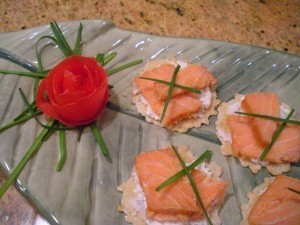
Rose Tomato and Chives Perk Up the Presentation
Saucy Sis1
[image error]
July 23, 2010
Make A Palm Tree Using Cucumber and Green Pepper
When I hosted our little “island-themed” dinner party a few weeks ago, I created a palm tree out of a cucumber and a green pepper. I used it on a platter of hors d’oeuvres. (I would have used that picture, but it was terrible. I really have to take some photography lessons.)
My only dilemma was how to make the cucumber stand up without falling over. I could have put in on a florist frog – if only I had had one. As I was rummaging through drawers for ideas, I came across some corn-on-the-cob holders, and…voila! I stuck them around the bottom of the cucumber and then covered them up on the platter with some big hydrangea leaves.
Directions for making the palm tree:
With a sharp paring knife, cut small semi-circular gashes into the skin of the cucumber. Make the cuts very thin and at least ½ inch long. Cut both ends of the cucumber so that they’re flat. Put the cucumber in ice water for a couple hours to allow the cuts to open.
Remove the bottom of the green pepper and remove the cores and seeds. Cut up into the peppers from the bottom, leaving the tops intact. Cut the sections to resemble leaves. Make diagonal cuts along the sides of the leaves. Put the pepper in ice water with the cucumber.
Attach the “leaves” to the “trunk” with whatever is handy. I used a couple sewing needles. Straight pins or toothpicks should work too.
When you’ve got it assembled, celebrate with a Mai Tai! I did. Actually two…but who’s counting?
Saucy Sis1
[image error]

